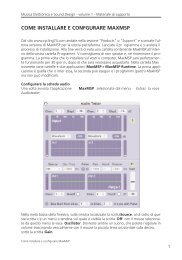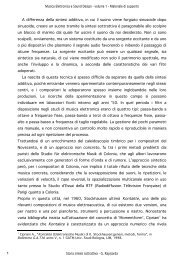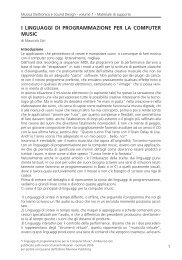programming with max/msp - Virtual Sound
programming with max/msp - Virtual Sound
programming with max/msp - Virtual Sound
Create successful ePaper yourself
Turn your PDF publications into a flip-book with our unique Google optimized e-Paper software.
4.2<br />
474<br />
Theory<br />
In the example, the instantaneous amplitude values of the sine wave generated<br />
by the LFO is used as input to two multipliers that inversely scale the<br />
amplitude of an audio oscillator on two output channels. Whenever the control<br />
signal reaches MIN (its minimum value), the sound is panned completely<br />
left, and whenever it reaches MAX (its <strong>max</strong>imum value), the sound is panned<br />
completely right. While intermediate values are being produced (represented<br />
in the figure by the central value INT), the sound is smoothly mixed between<br />
the two channels.<br />
It should be obvious that it would be possible to use other waveforms (triangle,<br />
random, etc.) to control parameter values in the same way; a square wave,<br />
for example, could control the location of a sound bouncing between left and<br />
right channels <strong>with</strong>out intermediate positions. In this case, there would be no<br />
continuous change, as there is when using a sine wave; the values would simply<br />
alternate between MIN and MAX.<br />
8<br />
INTERACTIVE EXAMPLE 4A • Panning using different LFO waveforms<br />
The rate <strong>with</strong> which values change depends on the frequency assigned to a<br />
given control oscillator. If you use a frequency of 1 Hz, you will move from MAX<br />
to MIN and back again in one second; if you use a frequency of .2 Hz, you will<br />
have 1 complete oscillation in 5 seconds. What if you use a frequency of 220?<br />
In this case, the 220 oscillations per second would be too fast to allow us to<br />
hear the location moving between left and right; this frequency would instead<br />
enter the audio range and would generate new components in the spectrum<br />
of the resulting sound. We will cover this phenomenon, amplitude modulation,<br />
in Chapter 10.<br />
8<br />
INTERACTIVE EXAMPLE 4B • Panning using a sine wave LFO at various<br />
frequencies<br />
By using control oscillators, we can control the depth and the rate of a vibrato,<br />
of a tremolo, or of variations in filter parameters, all of which we will cover in<br />
the following sections.<br />
(...)<br />
from “Electronic Music and <strong>Sound</strong> Design” Vol. 1 by Alessandro Cipriani and Maurizio Giri<br />
© ConTempoNet 2010 - All rights reserved<br />
Paragraph 4.2 - DC Offset







